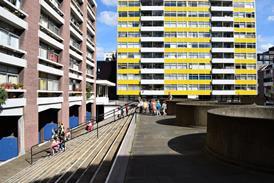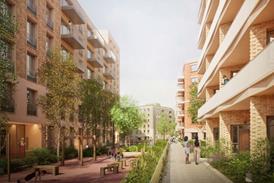As funding for over-21s on Level 7 architectural apprenticeships faces the axe, a practice director, an associate and a recent graduate explain why the route matters – and what its loss would mean for the future of the profession
The government’s decision to withdraw funding for over-21s on Level 7 architectural apprenticeships is a serious blow to one of the profession’s most effective and inclusive training routes.
It’s not just Level 7 architecture apprenticeships that are under threat, it’s the progress towards a more diverse and resilient profession that they have enabled.
Walk into many architecture studios today and you’ll still see a profession that remains stubbornly undiverse: male, white and, often, privileged.

Despite sincere efforts over the past decade, architecture still lags behind other sectors when it comes to inclusion.
However, you would have struggled to believe that if you’d attended the recent Birmingham City University (BCU) School of Architecture graduate show. It was a vibrant, compelling showcase, and a powerful reflection of what’s possible when we open up alternative routes into the profession.
The Level 7 route has been a quiet revolution. While the Level 6 apprenticeship has struggled to gain traction, the postgraduate Level 7 has proved far more viable for both students and practices, not least because it aligns more closely with the reality of contemporary practice, where few firms have the capacity to train students without the foundation of an undergraduate architectural education.
Level 7 apprentices are often older and subsequently bring more life experience. They work four days a week in practice and study one day a week at university, creating a mutually beneficial relationship where students learn by doing and practices retain staff while actively contributing to their professional growth.
It’s more than just cost-effective, it deepens learning, links theory to real-world application and produces architects who are often more mature, grounded and confident.
At BCHN, we’ve seen the value of this route first-hand. One of our colleagues, Simon Wilson, began his Level 7 apprenticeship 17 years after completing a degree in interior architecture.
He was part of BCU’s grad show and won the nomination for the RIBA Silver Medal, the second year in a row that a BCU apprentice has received the nomination. That is no coincidence.
Level 7 architectural apprenticeships are working. They are bringing in fresh voices, real-world experience and incredible talent
Architecture is not a narrow academic discipline. It demands lived experience, empathy and resilience, qualities often found in those who’ve taken non-traditional paths.

The Level 7 apprenticeship route opens the profession to people who may not have been ready for university at 18 or who needed time to discover their path. It offers a genuine alternative to the crushing financial burden of full-time Part 2 education, where costs en route to qualification can exceed £100,000 and deter even the most talented and committed.
It is hugely dismaying that the government has announced it will withdraw funding for Level 7 apprenticeships for those over the age of 21. It is a baffling decision that will, in effect, kill off the very pathway that is helping to reshape and democratise the profession.
At a time when we need broader representation, not narrower; when we need routes that support working-class students, second-chance learners and career-changers, this policy shift is nothing short of regressive. It not only undermines our sector’s commitment to inclusion but contradicts the supposed aims of a government that claims to value opportunity and social mobility.
Level 7 architectural apprenticeships are working. They are bringing in fresh voices, real-world experience and incredible talent. To lose them now would be to throw away one of the most promising tools we have for genuine transformation in architecture.
Michael Cruise is a director of Shrewsbury-based BCHN Architects. He was previously a studio director at Howells in Birmingham.
Why the apprenticeship route mattered to me
Taking the Level 7 Apprenticeship route was genuinely one of the best decisions I’ve made.

Financially, the full-time academic path just wasn’t feasible, but beyond that, I really didn’t want to step away from practice. I learn best by doing, and the apprenticeship offered the perfect balance between structured learning and real-world experience.
What made the course so valuable was the constant feedback loop between university and the workplace. I could immediately apply what I was learning (be that theory, regulation or design thinking) to live projects. It brought a depth and richness to both sides of my education that I really don’t think I would’ve had otherwise.
Being in practice also kept me energised. Instead of burning out, as so many students do after the rigours of the MA, I have actually found myself gaining momentum and really can’t wait to move straight into Part 3.
I can’t speak for all students, but the apprenticeship for me has been a great motivator.
That’s why it’s so frustrating and disappointing to see the Level 7 route effectively being phased out. It made the journey to becoming an architect more accessible, more inclusive and, honestly, more in tune with the way many of us learn and grow.
We talk a lot about improving access to the profession, but we need to back that up with real, tangible opportunities. I think the future of architecture depends on it.
Widuri Clare is an architectural assistant at Broadway Malyan’s Birmingham studio. She has just completed her MA in Architecture at Birmingham City University’s School of Architecture and Design as part of her Level 7 Architectural Apprenticeship, for which she received the course nomination for the 3D Reid design award.
Why the apprenticeship route worked for me
I’m probably not your typical apprentice.
I’m older than most, but that also means I can support younger students – help them see how theory meets the messiness of real projects. The apprenticeship isn’t an easy ride, but it was the right choice for me. It brings together academic rigour and real-life experience in a way that feels genuinely transformative.

My route to qualification as an architect isn’t typical. I studied interior architecture after completing an art foundation course, started working at BCHN Architects, did my Part 1 accumulative qualification and have since been promoted to associate.
Giving up work to return full time to university to complete my qualification was not an option. The apprenticeship route opened a door for me. Without it, becoming a qualified architect would not have been possible – I couldn’t afford to stop working, and the university route alone just didn’t fit anymore.
Now studying at Birmingham City University while continuing my role at BCHN, I’ve found that returning as a mature student gives me a different lens. I’m not just going through the motions to pass a module – I’m much more focused on the why.
The course pushes me to explore bigger ideas: sustainability, social impact, and how architecture evolves in a world that desperately needs it to.
For me, it’s not about ticking boxes. It’s about finally becoming what I’ve been working towards for years – but on my own terms.
Simon Wilson is an associate at Shrewsbury-based BCHN Architects. He recently completed his MA in architecture at Birmingham City University’s School of Architecture and Design as part of his Level 7 architectural apprenticeship, for which he received the course nomination for the RIBA Silver Medal.
Postscript
















No comments yet